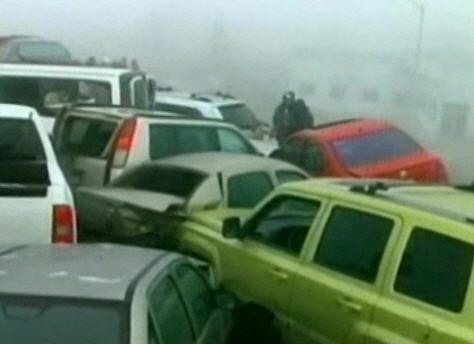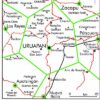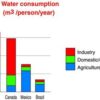Near-shoring means “the transfer of business or IT processes to companies in a nearby country, often sharing a border with your own country” (definition from SourcingMag.com). It is closely related to offshoring, now usually limited to similar transfers as near-shoring, but to more distant locations. Among the best examples of near-shoring are the hundreds of […]
The Transnational Metropolitan Areas of Mexico-USA

Mexico shares a 3,169 km (1,969 miles) border with the USA. This is one of the most heavily guarded and frequently patrolled land borders in the world, and a rare example of a land border that separates two countries with very different levels of economic development. These differences in development have, of course, prompted many Mexicans […]

Durango has long been considered the scorpion capital of Mexico (even the local soccer team became known as Los Alacranes, the Scorpions). At one point in the past, the city paid a bounty for each scorpion killed. Some historical accounts suggest that the scorpion catch rose dramatically, until the local authorities realized that some families […]
The 2010 censuses in the USA and Mexico have led to numerous reports on either side of the border. This post looks mainly at recent reports from the Pew Hispanic Center, a project of Pew Research Center, which describes itself as”a nonpartisan ‘fact tank’ that provides information on the issues, attitudes and trends shaping America […]
Could Southern California’s water woes be eased by a desalination plant in Mexico?
Southern California water officials are reportedly considering helping to finance a desalination plant in Mexico as a partial solution to their on-going water issues. A desalination plant proposed by San Diego County Water Authority and Metropolitan Water District of Southern California, and planned for north of the border in Carlsbad (San Diego County) has been […]
Mexico’s changing society: the phenomenon of “los ninis”

Los ninis are young people (aged 15-29) that “ni trabaja, ni estudia” (neither work nor study). They have become the focus of much press attention in the past couple of years, often accompanied by the phrase “Mexico’s lost generation”. This El Universal article cites Education Ministry (SEP) figures that there are more than 7 million […]
The troubled rise of the Green Movement in Mexico

Two specific events helped stimulate the rapid growth of Mexico’s green movement in the 1980s: the government’s role in the giant 1984 Pemex explosion its ineffective response to the disastrous 1985 earthquake These motivated many citizens to take direct action. Membership in Environmental Non-Governmental Organizations (ENGOs) surged, as “green brigades” aided the victims. Two months […]

According to data from Mexico’s Tourism Secretariat, the number of cruise ship passengers peaked in 2007, but has since declined, although their average spending has increased. The graph shows the number of passengers arriving on cruise ships to Mexican ports since 1995. This segment of Mexico’s tourism industry grew rapidly between 1995 and 2005. Cruise […]
Driving in Mexico: is it safe relative to other countries?

About 24,000 people were killed last year in traffic accidents in Mexico according to Ángel Martínez, Director of the Mexican Traffic Safety Research Center (Spanish acronym CESVI) . In the USA, the number was about 33,000 in 2010. Does this mean that is safer to drive in Mexico than the USA? The simple answer is […]
From Morelos to Minnesota; case study of a migrant channel between Mexico and USA

Axochiapan is a town and municipality in the small state of Morelos in central Mexico. According to the 2010 census, the population of Axochiapan municipality has grown only slowly over the past decade, from 30,436 in 2000 to 33,695 inhabitants in 2010, half of them living in the eponymous cabecera municipal (the main town of […]
Mexico’s Pemex: the government cash cow that environmentalists love to hate

Petroleos Mexicanos (Pemex), the giant, state-owned petroleum company, is a symbol of national pride with revenues of over $100 billion in 2008. However, it is cash poor because most of its revenue goes to the government, covering 40% of the national budget. Pemex is $40 billion in debt and its maintenance budget is insufficient to […]
This week’s “Sunday short” is about ziplines across the Guatemala-Mexico border, between El Carmen (Guatemala) and Talisman (Mexico). The story was reported by Mexico’s Televisa (a CNN affiliate). What might at first glance appear to be an enterprising form of adventure tourism is actually a means for undocumented migrants to enter Mexico on their way […]
Mexico has forty UNESCO-designated biosphere reserves

A surprising percentage of Mexico’s land area is protected in one form or another. A very large number of sites of archaeological or historical importance are managed by the National Institute of Anthropology and History, more commonly known by its acronym INAH. In theory, all buildings more than 100 years old have some degree of […]
Mexico D.F. administration offers amnesty to illegal water users
According to a recent report in Ooska News (8 June 2011), Mexico City authorities have announced an amnesty for people who regularize illegal water connections. No fines will be levied, and they will be encouraged to pay only 600 dollars (a 50% discount) for registering connections and connecting to the waste water drainage network. There […]
How will reduced out-migration impact Mexico’s total population?
As described in an earlier post –Is massive Mexican migration to the USA a thing of the past?– we examined a 6 July 2011 New York Times article which indicated that Mexican migration to the USA had slowed to barely a trickle. If this is correct, Mexico’s population will be considerably higher in future years. […]
With so much media attention focused on drug violence in Mexico, many potential tourists and tour operators are canceling planned trips to Mexico. Are such decisions rational? The analysis below indicates that travel to Mexico is considerably safer than risking vehicle traffic in the USA. The US State Department has issued numerous travel advisories concerning […]
Update: New Durango-Mazatlán highway officially open (Oct 2013) Update: October 2012: Despite earlier claims that the Durango-Mazatlán highway would be completed before the end of this year, government officials have now confirmed that the highway will not be finished, and will not open, until sometime in 2013. The Durango-Mazatlán highway in Mexico should open in […]
The spacing of central places in Mexico

Central place theory may work quite well in Mexico in terms of the relative numbers of settlements of different size, but the theory also suggests that those places on the same level of the urban hierarchy should form a distinctive spatial pattern and be roughly equidistant from one another. In essence, this means that each […]
Exhibition of National Geographic images of Mexico at the Mexican Cultural Institute in Washington D.C.

If you’re visiting Washington D.C. this summer, don’t miss the exhibition entitled Mexico Through the Lens of National Geographic: celebrating a century of visual exploration, on at the Mexican Cultural Institute in Washington D.C. through October 22. The exhibition features more than 130 National Geographic images of Mexico taken from feature articles published in […]
Round-up of recent developments in Mexico’s Drug War

Drugs smugglers are getting more and more creative in trying to circumvent drug trafficking and money laundering regulations either side of the Mexico-USA border. Flows of drugs northwards are counterbalanced by flows of cash southwards, since drug shipments have to be paid for somehow. What a shame that drug traffickers’ incredible ingenuity is not channeled […]
Mexico’s GDP/person reaches all-time high
According to the National Statistics agency (INEGI), Mexico’s GDP/person broke all records in the first quarter of 2011 to reach 9,985 dollars/person, 15% higher than the equivalent period of 2010. The rise is due to continuing economic growth, coupled with the strength of the Mexican peso against the US dollar and other major currencies. Mexico […]
The hierarchy of central places in Mexico
How well does central place theory fit the Mexican situation? In terms of the relative numbers of settlements of different size, it fits quite well. The theory suggests that there will be a regular (geometric) progression between the number of settlements of each successive size. The hierarchy of central places in Mexico is quite similar […]
Is massive migration of Mexicans to the USA a thing of the past?

Many people in the USA continue to blame undocumented Mexican immigrants for the country’s unemployment problems. These complainers do not seem to realize that the flow of undocumented Mexicans across the border has slowed to barely a tickle. The total number of Mexican immigrants peaked at about 550,000 in 2006 [see chapter 26 of Geo-Mexico: […]

Many Chicano activists refer to Mexicans as “La Raza”, literally “the race”. “Dia de la Raza” is celebrated on Columbus Day (October 12) as the day the Mexican indigenous population started their resistance against the European invasion. The term “La Raza” derives from a 1948 book “La Raza Cósmica.” The author Jose Vasconcelos’ thesis is […]
Central place theory and rural access to central place services
A previous post – The four basic types of rural locality in Mexico – indicates that access to sources of goods, services, markets and opportunities is very important to the economic and social well-being of rural and farm communities. Such sources are called central places and may be a village, a small town, a large […]
Severe hail storm hit central Mexico on 15 May 2011
The severe hailstorm which struck parts of central Mexico on 15 May 2010 lasted up to 30 minutes in some places. It was a particularly intense storm, with golf ball-sized hailstones up to 5 cm in diameter. The video below was uploaded to YouTube by iosergyout. (The commentary is in Spanish). The storm was caused […]
The four basic types of rural locality in Mexico
In a previous post, we looked at why Some rural areas are more rural than others.This post describes each of the four distinct categories of rural areas identified by Mexico’s National Population Council (CONAPO). Rural localities near cities This group is defined as localities within five kilometers (3 mi) of cities of at least 15,000 […]
Less water available each year in Mexico as population increases
Data from the National Statistics Institute (INEGI) show that Mexico’s available water has fallen to 4,263 cubic meters/person/year. Water availability depends on the amount of rainfall received each year and on total population. Mexico’s water availability has declined rapidly since 1950, when it was 18,053 cubic meters/person/year. Of 177 countries analyzed by the Food and […]
The availability of water in Mexico

Though parts of northern Mexico are arid, the country as a whole receives an average of 760 mm of precipitation a year (slightly over 30 in). This is a considerable amount, more than that received by either Canada or the USA. However, 73% of Mexico’s rainfall either evaporates directly or or is lost from plants […]
Some rural areas are more rural then others

We all recognize that some cities are more urban than others. For example, Mexico City is considered more urban that a town of 20,000. By the same token, some rural communities are more “rural” than others. For example, a small settlement located near a city or along a main road would be considered less rural […]